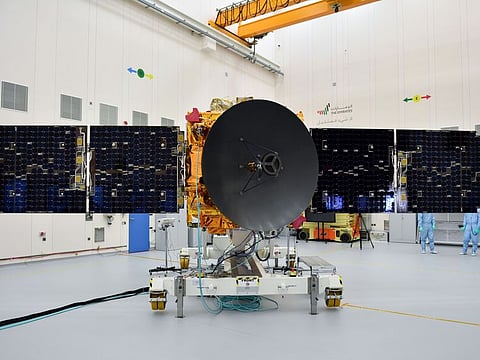UAE Mars Mission update: Emirati engineers conduct final tests
July 15 plan to launch the historic mission to Mars is on schedule

Also In This Package
Dubai: A team of Emirati engineers are conducting final tests on the Hope Probe to check that all systems are functioning prior to its scheduled launch from Japan’s Tanegashima Space Centre (TNSC) on July 15.
“The final checks are important steps to ensure that all systems are functioning and meeting the requirements before the fueling. Getting these parameters are vital prior to getting the Probe ready for the liftoff as per our launch window,” said Suhail Al Dhafri, Emirates Mars Mission (EMM) deputy project manager and Spacecraft Lead.
Leading the team are Omran Sharaf Al Hashemi, EMM project director; Al Dhafri: Omar Al Shehhi, launch team lead; Mohsen Al-Awadhi, risk Manager, Youssef Al-Shehhi, thermal systems engineer; Khalifa Al-Muhairi, communication systems engineer; Issa Al-Muhairi, power systems engineer; Ahmed Al-Yamahi, eechanical systems engineer, Mahmoud Al-Awadhi, mechanical systems engineer; and Mohammed Al-Amri, ground support systems engineer.
The Hope Probe has undergone a series of tests over a period of 50 working days since its arrival at TNSC in April. Engineers tested the spacecraft subsystems that include electrical power, communication, altitude control, command and control, propulsion, thermal control and software systems.
The team will then move the orbiter to the launch pad, install it on the rocket, and ensure the batteries are fully charged prior to liftoff.
Meanwhile, the 53-metre long and 289-tonne H-IIA rocket (launch vehicle No. 42 by Mitsubishi Heavy Industries or MHI) that will carry Hope Probe to Mars, has been filled with around 800 kilograms of hydrogen fuel and tested for leaks.
After fuelling, the EMM team will ensure that the Multi-Layer Insulation (MLI) and the arming plugs are properly sealed.
This will be followed by joint operations with the MHI on powering the spacecraft for aliveness test, confirming the preparations as well as charging the spacecraft batteries, and setting it for takeoff. This stage comprises three main tests, including battery charging, aliveness test, and spacecraft monitoring.
Shooting for Mars
The first interplanetary spacecraft by an Arab nation will lift off on July 15 at exactly 12.51.27am (UAE Time) from TNSC in Kagoshima Prefecture, southwestern Japan. The date is within the so-called launch window that lasts for about a month every two years when Earth and Mars are closest together.
Hope Probe should reach its desired orbit in the shortest possible time, which is around February next year.
Dr. Ahmad bin Abdullah Humaid Belhoul Al Falasi, Minister of State for Higher Education and the Chairman of UAE Space Agency, said: “Hope Probe is representative of the ambitions of the UAE and its positive message of hope to the region and the world. The core message is to strive passionately and overcome obstacles to find solutions that benefit the humanity at large, which exemplifies the UAE leadership’s vision. We are confident of the Hope Probe reaching the Mars orbit in February 2021, coinciding with the UAE’s Golden Jubilee celebrations,” he added.
Sign up for the Daily Briefing
Get the latest news and updates straight to your inbox









